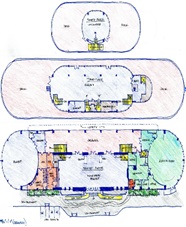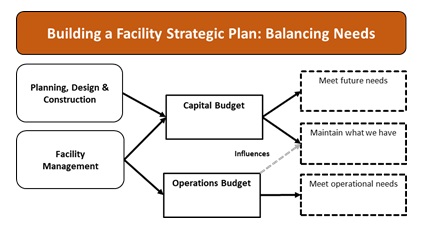by John Edwards, P.E., CFM, FMP and Chris Hodges, P.E., CFM, FMP, LEED AP — This article is Part Three of a three-part series addressing strategies for managing high-performing facility operations and delivering sustainable, resilient facilities. The themes of this series are shown in the following figure:
In Part One, the methods for conducting asset inventories, facility condition assessments, and implementing FM data systems were discussed in detail. The facilities data that results from ‘understanding what you have’ leads to analyzing how you use your assets, the subject of Part Two of this series. This article describes planning approaches that, when properly implemented, result in resilient, safe, healthy, productive and efficient facilities.
Organizations plan for their future facility needs using a variety of approaches, and their methods often reflect the maturity level of the facility team and its ability to guide and advise the broader organization it serves. Less mature organizations take an ad-hoc approach to long-term planning. They may wait for an external event (such as the catastrophic loss of a facility or the impending termination of a lease) to prompt any sort of major facility planning actions, or they may passively wait and act on opportunities that happen to present themselves (such as the vacancy of an adjacent building or parcel) before considering any major facility changes.
More mature facility teams help determine the future of an organization’s facilities by deliberately considering the mission, vision and values of the organization of which they are a part, aligning facility goals with the parent organization’s goals, and implementing long-term planning approaches such as master planning, space use analysis, and life-cycle management.
Master Planning
Master planning can take a variety of forms, depending on the nature of the organization and the purposes for which it is undertaking the master planning effort. For example, in a higher education context, a university may choose to develop a campus master plan to better shape the academic environment and enable enrollment growth. Typical elements in these plans consider aspects such as research and teaching needs, the student experience on campus, sustainability goals, and flexibility for growth or changing conditions in the future. The output often describes a series of new construction or major renovation projects that should be undertaken over the master plan period (often 10 or 20 years) to achieve the desired outcomes that support the institution’s mission.
 In contrast, a master plan for a municipal government or public agency may be more focused on how to better use existing facilities and minimize spending while maintaining an acceptable level of service to the constituents they serve. In this context, the master plan will often include an analysis of the types of services offered, opportunities for organizational changes that could eliminate the need for new or expanded facilities, and an assessment of available data for facility conditions and functionality. The output from these types of master plans often describes recommended changes to business practices, opportunities for facility consolidation and footprint reduction, and business case analyses for limited renovation projects.
In contrast, a master plan for a municipal government or public agency may be more focused on how to better use existing facilities and minimize spending while maintaining an acceptable level of service to the constituents they serve. In this context, the master plan will often include an analysis of the types of services offered, opportunities for organizational changes that could eliminate the need for new or expanded facilities, and an assessment of available data for facility conditions and functionality. The output from these types of master plans often describes recommended changes to business practices, opportunities for facility consolidation and footprint reduction, and business case analyses for limited renovation projects.
Regardless of the form the master plans take, they all serve a common purpose: to strategically align the facilities of the future with the organization’s vision following a structured, well-thought-out approach.
Efficient Space Use
A holistic review of current space use and future space needs is normally a part of the master planning process described earlier. The space needs identified in master planning help to drive portions of the program and determine the necessary facility actions to be taken. However, a comprehensive space review can also be undertaken as an exercise unto itself and become another effective approach for proactively planning for the future.
Each square foot of space that an organization occupies comes at a price, whether that is reflected in a lease payment or in the operations and maintenance costs of an owned facility. Mature facility organizations purposefully consider the amount of space the broader organization needs and continuously review the efficiency of use of the space it occupies. These practices support the principles of efficiency and sustainability in facility management.
A key element in determining the appropriate amount of space needed for the functions a location supports is space standards. If an organization has not yet established space standards, there are many publicly-available resources that can be consulted to help with the development of space guidelines that fit an organization’s mission.
Some organizations are reticent to establish space standards, or even broad space use guidelines, for fear of backlash from management or employees. The amount of space a person or department occupies is sometimes perceived as a symbol of the importance or power of the occupant, and establishing standards threatens the continued amassing of space. However, with appropriate space guidelines and support from top management in implementation of the standards, a facility manager can help the larger organization begin to plan for future space needs in a measured way.
Ongoing review of the efficiency of space use can also help the facility manager to ensure that space standards are being maintained. Many space planning and management tools allow for reporting of space metrics such as utilization rate of shared rooms or square footage per occupant. It is incumbent upon the facility manager to determine the metrics that best measure the outcomes described by their organization’s space standards and monitor those metrics for efficiency of space use.
Effective Life-Cycle Management
The master planning and space use approaches described earlier show their greatest value when their outcomes are incorporated into a life-cycle approach to facility management. Translating the organization’s plans and desired facility projects into a facility management financial strategy is often the best way for a facility manager to garner the attention and support of C-suite executives.
Creating a strategic approach to facility asset management that maximizes facility life cycle and delivers cost effective facility services requires the facility team to understand stakeholder needs and the tradeoffs of new facilities versus repairs, replacements, or renewal of what you have. Building a strategic funding plan for life-cycle management requires the development of a Facility Strategic Plan (Figure 1) and Strategic Funding Model (Figure 2) that addresses those competing needs.
As shown in Figure 1, the two major groups in most facility teams (Planning, Design and Construction and Facility Management) rely on two primary sources of funds to execute their parts of the strategy: the capital budget and operations budget. While organizations may have varying thresholds that determine how expenditures are categorized, the most basic distinction is that the capital budget provides funds for items that are expected to last longer than one year and the operations budget funds items that are for less than one year (normally, the current fiscal year only). The work that is executed from the combination of the fund sources results in life-cycle expenditures that meet current operational needs, provide sustainment for existing assets, and invest to meet future needs.
Figure 2 shows an example of how to strategically address funding in categories that are common to many organizations. Pillar I, Operational Funding, reflects the operational expenditures to meet day-to-day needs in the current fiscal year. The remaining pillars are classifications of capital expenditures that help to preserve assets and provide for future capabilities.
Summary
The most effective facilities team are those that can take a typical “list of projects” that has been thoughtfully prepared through a long-term planning process and communicate the needs to the organization’s leadership through a Strategic Facility Plan and Strategic Funding Plan. This life-cycle approach to facility asset management will position the organization to provide facilities that are safer, healthier, and more efficient in meeting mission needs.
John Edwards, P.E., CFM, FMP is a facility management consultant at FEA where he helps clients improve the way they manage their facilities. John is a registered Professional Engineer in the Commonwealth of Virginia and a Certified Facility Manager through the International Facility Management Association (IFMA). He has earned IFMA’s Facility Management Professional certificate and teaches in the FMP Program.
Chris Hodges, P.E., CFM, FMP, LEED AP is a founder and Principal of FEA. Chris is a registered Professional Engineer in multiple states, a Certified Facility Manager and Facility Management Professional through the International Facility Management Association (IFMA), and a LEED Accredited Professional. Chris teaches in multiple IFMA programs and currently chairs IFMA’s Certificate Commission.


